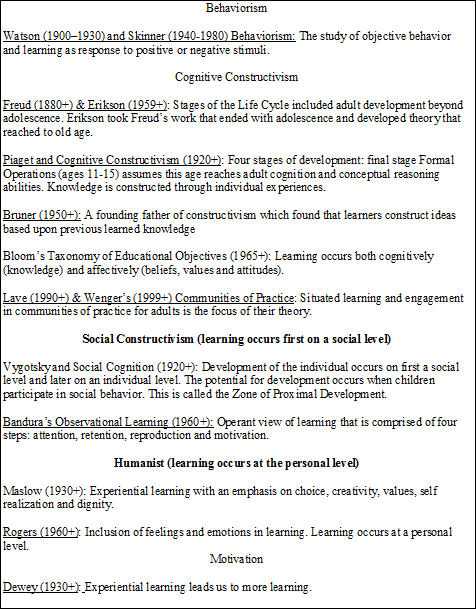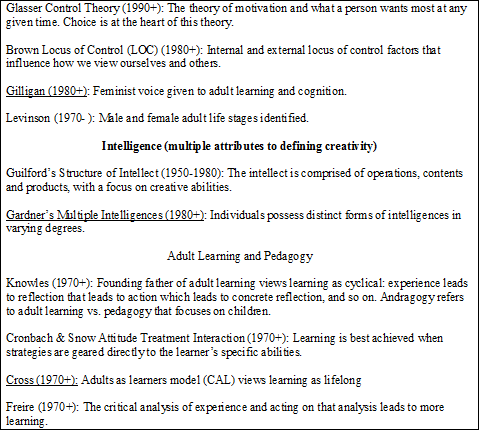| << Chapter < Page | Chapter >> Page > |
Is the 18 to 23 year old similar to the 30 to 40 year old? Or, the 50 to 60 year old? Common sense tells us that life experience through our lifetime greatly influences our motivation, ability to learn, and the attention we choose to give learning. From the time we exit mandatory schooling and transition to learning that we choose, such as continuing into college or working at a job we are happy with, we begin adult learning. Adult learning is learning done on a continuum from the adolescent-adult stage forward.
How we learn and help others to learn is the sub-context for this chapter. Some tie learning to personal motivators, ala, Bandura, Brown, Bloom, Dewey and Glasser. Others focus on innate individual differences, ala, Gardner, and Guilford. And for others behaviorism or learning as cognitive constructivism (learners construct knowledge based on previous knowledge) is the prime importance to defining learning. Learning-based theories describe the learner from a variety of key points. Presented in Table 1 are the learning theories by category listed by the key researcher and the approximate time their theories were developed.
Table 1: Learning Theories and Timeline of Theory Development

Table 1 (continued)

Beginning with Behaviorism, Watson and subsequently the famous B.F. Skinner believed that behaviorism was the key to learning through the use of positive or negative stimuli. Behaviorism is limited in its range for addressing adult leaner needs as it does not consider cognitive and affective processes.
Numerous perspectives have contributed to cognitive constructivism. Piaget viewed cognitive construction as having 4 stages. For the purposes of the textbook, we are focused on stage four, Formal Operations for ages 11 to 15 which assumes that this age reaches adult cognition and conceptual reasoning abilities. Knowledge from this point forward is constructed through individual experiences. Some credit the work with children that Piaget did, as the inventor of the field of cognitive development (Gardner, 2006). Criticism of Piaget has been found in his lack of acknowledging individual differences and in minimizing cultural, social, and ignoring motivational factors.
Bruner is considered to have been one of the original thinkers in cognitive constructivism. Learning is an active process. Learners construct new ideas based upon their existing knowledge. Bruner (1983) stated, “Knowing how something is put together is worth a thousand facts about it” (p.183).
Parallel to Piaget and Bruner, personality theory from the mid 1950’s in adult research began to take the view that all learning does not end with adolescence. In personality theory, Erik Erikson’s eight stages of life expanded Freud’s view of five stages and challenged the notion that development ended with adolescence. Erikson took Freud’s original five stages and expanded them to eight to include adult development. These additional stages are: Stage 6-young adult (late teens through twenties) characterized by intimacy vs. isolation, seeking partners and friends; Stage 7-middle adult (thirties to fifties) characterized by generativity vs. self-absorption, seeking a meaningful home and workmates; and, Stage 8-old adult (sixties and beyond) characterized by integrity vs. despair.

Notification Switch
Would you like to follow the 'Ncpea handbook of online instruction and programs in education leadership' conversation and receive update notifications?